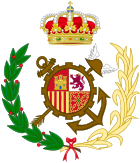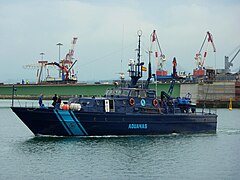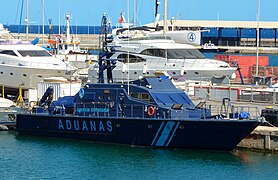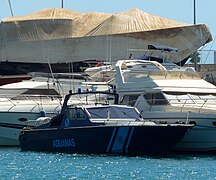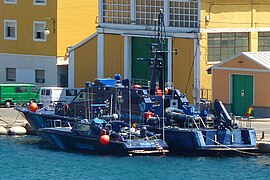
A coast guard or coastguard is a maritime security organization of a particular country. The term embraces wide range of responsibilities in different countries, from being a heavily armed military force with customs and security duties to being a volunteer organization tasked with search and rescue without law enforcement authority. In most countries, a typical coast guard's functions are distinct from those of the navy and the transit police, while in certain countries they have similarities to both.

A patrol boat is a relatively small naval vessel generally designed for coastal defence, border security, or law enforcement. There are many designs for patrol boats, and they generally range in size. They may be operated by a nation's navy, coast guard, police, or customs, and may be intended for marine, estuarine, or river environments.
SVA is an initialism that may refer to:
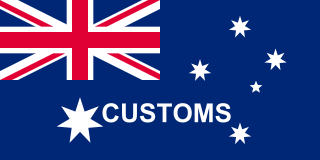
The Australian Customs and Border Protection Service was an Australian federal government agency responsible for managing the security and integrity of the Australian border and facilitating the movement of legitimate international travellers and goods, whilst protecting the safety, security and commercial interests of Australians. It was headquartered in Canberra and employed over 5,800 people around Australia and overseas.

Water police, also called bay constables, coastal police, harbor patrols, marine/maritime police/patrol, nautical patrols, port police, or river police are a specialty law enforcement portion of a larger police organization, who patrol in water craft. Their patrol areas may include coastal tidal waters, rivers, estuaries, harbors, lakes, canals or a combination of these.
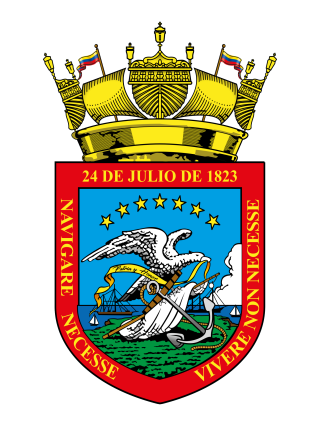
The Bolivarian Navy of Venezuela, commonly known as the Venezuelan Navy, is the naval branch of the National Bolivarian Armed Forces of Venezuela.

A border guard of a country is a national security agency that performs border security. Some of the national border guard agencies also perform coast guard and rescue service duties.

Air and Marine Operations (AMO) is a federal law enforcement component within U.S. Customs and Border Protection (CBP), an agency of the United States Department of Homeland Security (DHS). AMO's mission is to protect the American people and nation's critical infrastructure through the coordinated use of air and marine assets to detect, interdict and prevent acts of terrorism and the unlawful movement of people, illegal drugs, and other contraband toward or across the borders of the United States. Air and Marine Operations Agents and Officers are endowed with the authority to enforce Title 8 and Title 19 (Customs) of the United States Code in addition to the general law enforcement powers bestowed upon federal law enforcement agents.
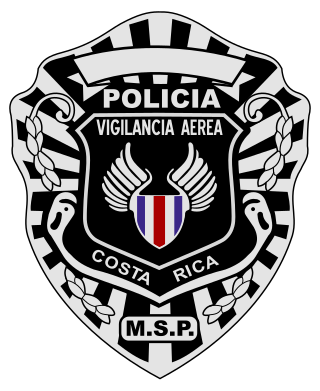
There is officially no Air Force of Costa Rica; the only air wing in existence is attached to the Public Force of Costa Rica. Currently this unit, officially called Air Vigilance Service, also called the Air Service, does not operate any armed military aircraft. Its main air bases located in three different points, San José being the main operations center.
The Fiscal and Customs Police is a unit of the Colombian National Police under the command of its Operative Directorate. The unit is in charge of investigating large financial frauds, and usually supports the National Directorate of Taxes and Customs.
Law enforcement in Spain is carried out by numerous organizations, not all of which operate in the same areas.

The Marine Unit, formerly the Australian Customs Service National Marine Unit, is a division of the Australian Border Force which acts as a Coast Guard in guarding Australia's coast. The Marine Unit focuses on surveillance and response activities within the Australian Economic Exclusion Zone, and the operation and training of ships and crews to do so.

The Directorate-General of Customs and Indirect Taxes, commonly known as les douanes (Customs), is the customs service of the French Republic. It is responsible for levying indirect taxes, preventing smuggling, surveilling borders and investigating counterfeit money. The agency acts as a coast guard, border guard, sea rescue organisation, and customs service. In addition, since 1995, the agency has replaced the Border Police units of the National Police in carrying out immigration control at smaller border checkpoints, in particular at maritime borders and regional airports.

The National Aeronaval Service of Panama, also called SENAN, is a branch of the Panamanian Public Forces which is responsible for carrying out naval and air operations. Its role is to perform protection, surveillance, security and defense of the air and maritime jurisdictional areas. The service has approximately 3,700 personnel, with 19 boats and approximately 24 aircraft.

The Indonesian Sea and Coast Guard Unit is an agency of Government of Indonesia which main function is to ensure the safety of shipping inside the Indonesian Maritime Zone. KPLP has the task of formulating and execute policies, standards, norms, guidelines, criteria and procedures, as well as technical guidance, evaluation and reporting on patrol and security, safety monitoring and Civil Service Investigator (PPNS), order of shipping, water, facilities and infrastructure of coastal and marine guarding. KPLP is under the Directorate General of Sea Transportation of the Indonesian Ministry of Transportation. Therefore, KPLP reports directly to the Minister of Transportation of the Republic of Indonesia. KPLP is not associated or part of the Indonesian National Armed Forces. KPLP, however often conduct joint-exercise and joint-operations with the Indonesian Navy.

Naiguatá (GC-23) was a 79.9-metre (262 ft) Guaicamacuto-class patrol boat of the Venezuelan Coast Guard. The vessel was constructed by Navantia in Cádiz, Spain beginning in 2008. On 30 March 2020, the vessel collided with the cruise ship RCGS Resolute in international waters and sank.

Louise Michel is the name of the former French patrol boat Suroît, originally built for the Directorate-General of Customs and Indirect Taxes. It was refitted in 2020 to patrol rescue zones in the Mediterranean Sea.

The ship Life is a former fishing cutter, which was used in the Mediterranean from 2017 to 2018 under the name Seefuchs for the Sea-Eye association from Regensburg as a rescue ship between Malta and Libya. In 2019 the ship was given away to the Spanish organisation Proem-Aid. In 2021, the ship was intercepted in international waters with a large drug load after being bought by drug dealers, in a joint investigation by the Guardia Civil and the Servicio de Vigilancia Aduanera.

